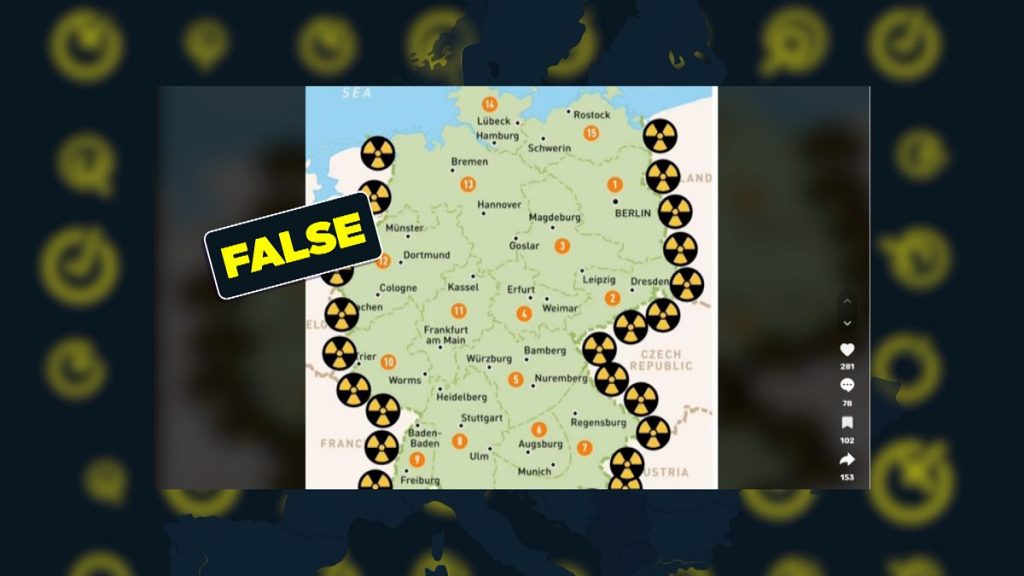The resurgence of an outdated and misleading map depicting Germany’s borders encircled by 30 nuclear power plants has sparked online discussions about the future of energy production in Europe. This map, circulating across various social media platforms, falsely portrays a concentration of nuclear facilities immediately adjacent to German borders, suggesting that Germany will become reliant on its neighbors for nuclear energy in the coming years. Posts accompanying the map often imply that Germany’s decision to phase out nuclear power will leave it lagging behind its neighbors in energy production, fueling a narrative of German energy dependence. However, the reality of nuclear power distribution in Europe starkly contrasts with this misleading portrayal.
A closer examination of Europe’s nuclear landscape reveals a far different picture. While some of Germany’s neighbors do operate nuclear power plants, they are not strategically positioned along the borders as the map suggests. Moreover, several of Germany’s bordering countries have no nuclear power plants at all. The map’s inaccuracies not only misrepresent the physical location of these facilities but also inflate their numbers. The map’s propagation online contributes to a distorted understanding of Europe’s energy infrastructure and fosters unwarranted concerns about Germany’s energy future.
Authoritative sources, such as Nucleareurope, a trade association for the nuclear energy industry, provide a more accurate depiction of nuclear power plant locations in Europe. These sources confirm the presence of nuclear facilities in some of Germany’s neighboring countries, but their distribution is far more dispersed than the misleading map suggests. The map’s misrepresentation extends beyond the geographical placement of plants to the very existence of nuclear facilities in certain countries. The reality is that several countries bordering Germany do not operate any nuclear power plants, further highlighting the map’s inaccuracies.
To understand the current state of nuclear energy in Europe, it’s essential to consult reliable data. The World Nuclear Association, a prominent source of information on nuclear energy, provides updated figures on the number of operational nuclear reactors in different countries. According to their data, France leads Europe with the highest number of operable nuclear reactors, followed by Russia, Ukraine, the UK, and Spain. While some of Germany’s neighbors, including Belgium and Switzerland, do possess operational nuclear reactors, their numbers are significantly less than what the misleading map portrays. This data underscores the importance of relying on credible sources for accurate information on nuclear energy distribution.
Germany’s decision to phase out nuclear power, culminating in the shutdown of its last nuclear power plants in April 2023, reflects a long-standing policy commitment. This decision, approved in 2011, stemmed from concerns about the safety and long-term sustainability of nuclear energy. The misleading map, however, attempts to frame this policy decision as a strategic disadvantage, suggesting that Germany will be forced to rely on its neighbors for nuclear power. This narrative overlooks Germany’s commitment to developing renewable energy sources and diversifying its energy mix.
In conclusion, the misleading map circulating online presents a distorted view of Europe’s nuclear energy landscape and misrepresents Germany’s energy future. It’s crucial to rely on authoritative sources and accurate data to understand the distribution of nuclear power plants in Europe. While some of Germany’s neighbors do operate nuclear facilities, their numbers and locations are vastly different from what the map depicts. Germany’s decision to phase out nuclear power is part of a broader energy strategy focused on renewable sources and diversification, a fact often overlooked in the narratives surrounding the misleading map. The propagation of such inaccurate information underscores the importance of critical thinking and media literacy in the digital age.

